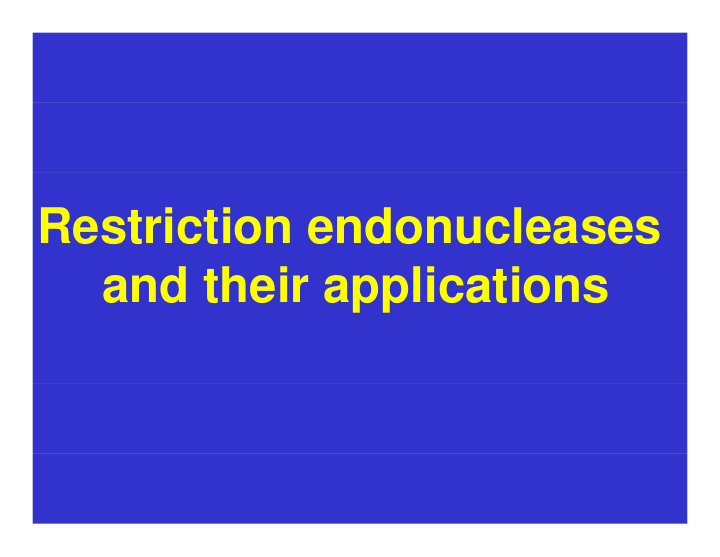



Restriction endonucleases est ct o e do uc eases and their applications
Hi t History of restriction f t i ti endonucleases and its role e do uc eases a d ts o e in establishing molecular bi l biology
Restriction enzymes • Over 10,000 bacteria species have been screened for restriction enzymes • Over 2,500 restriction enzymes have been found O 2 500 t i ti h b f d • Over 250 distinct specificities • • Occasionally enzymes with novel DNA sequence Occasionally enzymes with novel DNA sequence specificities are still found while most now prove to be duplicates (isoschizomers) of already di discovered specificities. d ifi iti
Restriction Enzyme Function • It is generally believed that the biological function of restriction enzymes is to protect cells from foreign DNA. • Infecting DNA is cleaved (restricted) by the restriction enzyme(s) preventing it f from successfully replicating and f ll li ti d parasitizing the cell.
Why the bacteria does not kill itself? The Restriction Enzyme Modification Systems if everything gets cleaved, how come the bacteria does not kill itself? • Usually, organisms that make restriction enzymes also make a companion modification enzyme (DNA methyltransferase) that protects their own ( y ) p DNA from cleavage. • These enzymes recognize the same DNA y g sequence as the restriction enzyme they accompany, but instead of cleaving the sequence, they disguise it by methylating one of the bases in each DNA strand. h DNA t d
Classification of Restriction enzymes enzymes Class I Class II (93%) Class III Restriction-methylase Homo-dimers, Restriction-methylase on the same subunit methylase on a on the same subunit separate subunit p ATP-dependent Mg++ dependent ATP-dependent Binds to DNA recognize symmetric Cut the DNA at the recognition site and DNA sequences and recognition site and cuts DNA randomly - t DNA d l cleave within the l ithi th th then dissociate from di i t f any DNA as long as it sequences the DNA comes in contact
Type II Restriction enzymes are endonucleases that cut DNA at specific sites, and are most useful for molecular biology research
Type II Restriction enzymes Recognition sites Recognition sites are P li d Palindroimes: i 121 IFFI ABA IFFI, ABA AAGCTT TTCGAA
How do I know what sequence How do I know what sequence each enzyme cut? • Test by cutting DNA of known sequence y g q Commercial sources are tested already, y, • and you find a catalog
Some popular Biotechnology Companies • Life Technologies (BRL/GIBCO) • New England Biolabs • Amersham Pharmacia Biotech • Qiagen • Promega P • Clonetech • Invitrogen Invitrogen • Stratagene • ...
Nomenclature of restriction enzyme • Eco R1: E coli • Pst I: Providencia stuartii • Hin d III: Haemophilus influenza • Not I: Norcardia otitidis-caviarum • What do you name a restriction enzyme What do you name a restriction enzyme isolated from Xanthomonas graminis ?
How long is the recognition sequence • 4 bp: e.g., Taq 1, HpaII, MspI • 6 bp: e.g., EcoR1, HindIII, BamH1, PstI, salI • 8 bp: Not I, Sfi I
Recognition sequence may be Recognition sequence may be interrupted or ambiguous Acc I: GT(at/gc)AC ( g ) Bgl I: GCCNNNNNGGC g Afl III: ACPuPyGT Afl III: ACPuPyGT
Three types of ends produced Three types of ends produced by type II restriction enzymes • 3’-overhang (protruding) • 5’-overhang 5 overhang • Blunt end
5’-overhang EcoR I 5’-----------------------gaattc---------------------------3’ 5 -----------------------gaattc---------------------------3 3’-----------------------cttaag--------------------------5’ X EcoR1 5’-----------------------g g + aattc---------------------------3’ + aattc 3 3’-----------------------cttaa g---------------------------5’
3’-overhang Pst I: 5’-----------------------ctgcag---------------------------3’ 5 -----------------------ctgcag---------------------------3 3’-----------------------gacgtc--------------------------5’ X PstI 5’-----------------------ctgca-3’ g 5’-g---------------------------3’ 5 g 3 + + 3’-----------------------g-5’ 3’- actgc---------------------------5’
Blunt end EcoR V 5’-----------------------gatatc---------------------------3’ 5 -----------------------gatatc---------------------------3 3’-----------------------ctatag--------------------------5’ X EcoR V 5’-----------------------gat g atc---------------------------3’ atc 3 + + 3’-----------------------cta tag---------------------------5’
Only Compatible, base-pairable ends can ligate li t
Odds of cutting at a segment of DNA 4 bp cutter: 4 4 = 256 bp • 6 bp cutter: 4 6 = 4 kb • p 8 bp cutter: 4 8 = 64 kb • • ??? How many do you predict Eco R1 to cut catfish genome of 8 x 10 9 bp g p
What do you expect if What do you expect if you digest with your you digest with your plasmid DNA with 4- p bp cutters
What do you expect if What do you expect if you digest with your you digest with your plasmid DNA with 6- p bp cutters
What do you expect if What do you expect if you digest with your you digest with your plasmid DNA with 8- p bp cutters
Restriction mapping EcoR1 EcoR1 EcoR1 Pst I Pst I E P E E P 0.6 kb 2.4 kb 6.0 kb 1.0 kb 7.7 kb 1.5 kb 0.8 kb 10 kb 10 kb What do you expect to see with double digest, if reaction is complete? 0.6 kb, 0.9 kb*, 1.5 kb, 6.0 kb, 0.2 kb, 0.8 kb.
What do you expect if What do you expect if you digest with your you digest with your genomic DNA with 4- g bp cutters
What do you expect if What do you expect if you digest with your you digest with your genomic DNA with 6- g bp cutters
What do you expect if What do you expect if you digest with your you digest with your genomic DNA with 8- g bp cutters
Selection of restriction Selection of restriction enzymes Of Over 250 commercially available and over 2,000 total, how do I know what to use? • Cutting frequency Easy to work with • • Economical
Recommend
More recommend